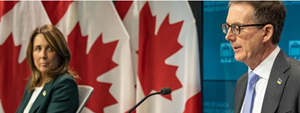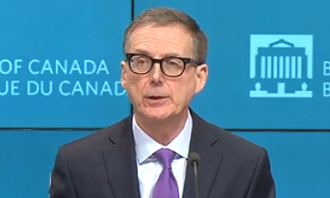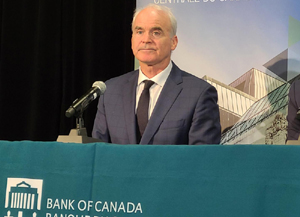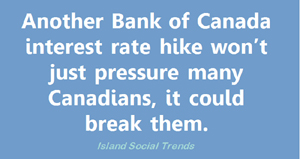Friday July 7, 2023 | VICTORIA, BC [Updated July 11, 2023]
by Mary P Brooke, B.Sc., Cert PR | Island Social Trends
SECTIONS: ECONOMY | FOOD SECURITY
On Wednesday July 12, 2023 the Bank of Canada will announce its decision on the target for the overnight rate. The last update was on June 7, when the bank rate was increased by 25 basis points to 4.75%.
The announcement through a press release will be made at 10 am Eastern (7 am Pacific). Tiff Macklem, Governor of the Bank of Canada, and Carolyn Rogers, Senior Deputy Governor, will hold a press conference at 11 am EDT (8 am Pacific).

The Bank is this year still continuing it efforts to tamp down inflation. They have ratcheted up the interest rate nine times in the past 16 months: seven times in 2022, an eighth time in January 2023, and the ninth time last month.

[Timeline: Interest rates sat at 0.25% for quite a while after the fallout from the 2008 Great Recession. In 2022, the interest rate was first increased in response to inflation on March 3, by 0.25% to 0.50%. Then on April 14 there was a significant jump all at once to 1.0%. That was quickly followed by a jump to 1.75% on June 2, 2022. That was followed by a massive jump of one full percent up to 2.5% on July 14. On September 8, the rate was pushed up again, to 3.25%, where it sat for a short time, being followed by an increase to 3.75% on October 27 and to 4.25% on December 8, 2022. When the rate was increased to 4.55% on January 26, 2023 the Bank of Canada implied that the new level was probably it for a while. But they did say they would keep an eye on the progress of pushing down the rate of inflation to between the 2% and 3% range.]
Intended to cause pain:
These rate increases are intended to cause economic pressures on consumers to make them spend less. The increases are supposed to prevent ‘normalization’ of inflation, as bank leaders have said. The Bank still operates by the view that an interest rate in the range of 2 to 3 percent makes inflation ‘disappear’, i.e. people don’t think about it and businesses don’t respond with regular price increases.
However, every time the bank notches up their rate, the rest of the business and financial sectors follow suit — that sort of ‘normalization’ is serving to erode consumers.
Without consumers, mortgage-payers, renters and people shopping, what’s left of an economy, not to mention the social structure that shores up families and communities?
Businesses seeking reprieve:

When the Deputy Governor of the Bank of Canada, Paul Beaudry, addressed the Greater Victoria Chamber of Commerce on June 8, the day’s emcee (Bruce Williams, CEO, Greater Victoria Chamber of Commerce) pitched on behalf of local businesses that no further rate increases would be welcome news.
Notably, in the CTV money-talk show Taking Stock, host Amanda Lang recently suggested that financial institutions take on a bit more risk to help out struggling businesses. That would be welcome news at any time (Canadian banks are highly conservative and don’t seem to find the words ‘reasonable risk’ in their lexicon), but ever more so is needed now.
A simple small loan or line of credit at a reasonable rate would keep many small businesses afloat instead of crumpling under the intense pressure of the financial scenario of the past year or two.
Faulty assumptions:
The fault in this approach is that there’s an assumption that many or most Canadians have wiggle room in their budgets and have room to cut back on discretionary spending.
As one point to note, this week 11 million Canadian individuals or households received an affordability tax credit (aka grocery rebate) — that’s 27.5 percent of the Canadian population. Those folks often have little to no discretionary income after buying groceries, putting a roof over their heads, and paying regular bills.
The banks and insurance companies push up their interest rates in response to Bank of Canada rate increases, with most if not all businesses and services following suit. That adds to the cost of nearly everything. Some people are fortunate enough to perhaps find a higher-paying job or launch a side-hustle business. But overall, people’s incomes are not increasing anywhere near the rate of inflation, if at all.
There is also an assumption that market forces operate the same way that they did in the 1970s and 1980s, i.e. playing with a balance between GDP, the consumer price index, and the labour market. Surveys and statistics have now, for weeks, been showing that the economy is defying the ‘normal’ parameters — hiring is strong (possibly because new emerging sectors need new employees, and because people who already have good jobs are in the driver’s seat to move up the ladder).
Meanwhile, the rest of society is falling behind, with many people unable to meet rent/mortgage payments, or have very little remaining to spend after covering bills. The dry stats might satisfy bankers but the lived reality of such strain is very likely contributing to mental health issues, longer-term physical health impacts, and disruption of family and social norms.
One blunt tool is causing harm:
Using one blunt tool — i.e. increasing the Bank of Canada rate — is simplistic and harmful to many. The federal government (and some provincial governments — with BC being among the most responsive) have tried to ease the burden with affordability credits to low income individuals and families. But the great divide is becoming even wider between the have’s and the have-not’s in this so-called ‘rich’ country.
The range of small and continuing failures for people by governments across Canada (federal, provincial and municipal) should be an embarrassment — the overall cost of living (with groceries and mortgage/rent being the most noticeable) is already at a crisis level.
How much farther do economic leaders expect Canadians to bend before breaking? Many are already broken … homeless (including the ‘hidden homeless’ who couch-surf or find roommates, or even switch to an RV or mini-home lifestyle in order to survive), and becoming both undernourished (surveys are showing that many Canadians are buying less food now compared to years past), and underfed (food bank client traffic has increased dramatically in the past year or two). When people flee in all directions just to survive, that serves to break down families and communities.
This week a senior economist at one of Canada’s six big banks is urging the central bank to stop raising rates. “History could show that the recent Bank of Canada rate hike (and any subsequent moves) was at best unnecessary, and at worst a mistake,” said CIBC senior economist Andrew Grantham in a report. He calls recent hikes “unnecessary” and argues that consumer spending remains lower than it was just before the COVID pandemic hit in March 2020.
Tuning in July 12:
On July 12, a press release will provide a brief explanation of the decision and the live teleconference session will be available later on the Bank of Canada website. The Bank will publish its quarterly Monetary Policy Report (MPR) at the same time as the rate decision.
===== RELATED:
Bank of Canada Deputy Governor draws a crowd in Victoria (June 8, 2023)
Small bank rate increase is still an economic shock (January 25, 2023)
SECTIONS: ECONOMY | FOOD SECURITY
===== ABOUT THE WRITER:
Mary P Brooke has been writing insight-news since 2008. Her publication series has covered news of the day through broader socioeconomic and political insights in the west shore region as well as key sociopolitical and socioeconomic issues of today’s society, as published by Brookeline Publishing House Inc under these mastheads: MapleLine Magazine (2008-2010), Sooke Voice News (2011-2013), West Shore Voice News (2014-2020), and Island Social Trends (since 2020).
The Island Social Trends print edition (previously West Shore Voice News) launches later in July 2023, after a three-year hiatus during the pandemic years, while continuing here online at IslandSocialTrends.ca. The print-bound copies of MapleLine Magazine, Sooke Voice News and West Shore Voice News are already part of the permanent collections at the Sooke Region Museum.
Ms Brooke now reports with the BC Legislative Press Gallery, as part of delivering regional news on Vancouver Island.
This year, Mary P Brooke has been nominated for the Jack Webster Foundation Shelley Fralic Award to recognize a professional female journalist whose journalism makes a contribution to the community.
LINKS: About Mary P Brooke | About Island Social Trends | Subscribe to the Island Social Trends Premium ENews






